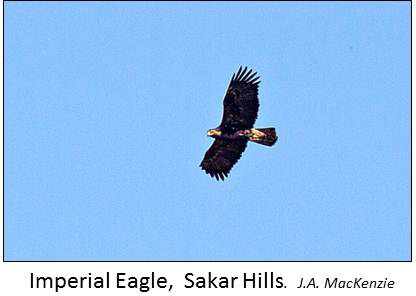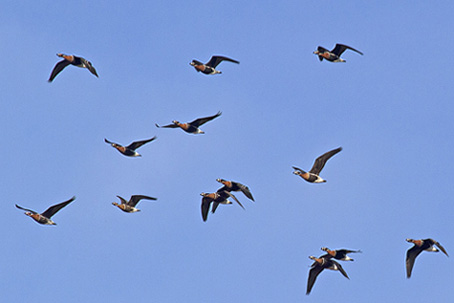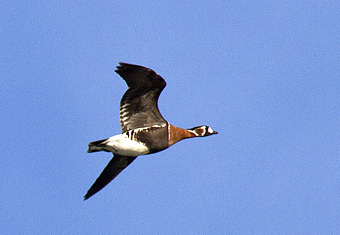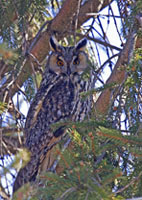Photos with this report (click to enlarge) | |||
 Eastern Imperial Eagle |
 Red-breasted Goose |
 Red-breasted Goose |
|
 Long-eared Owl |
|||
General:
Bulgaria is not a well-known birding destination for Canadians—especially western Canadians—due to the distance from home. In spite of that distance, travelling to and from is not difficult. This was my second very enjoyable visit in five months. This time, the target was primarily Red-breasted Goose, a species that I had long wished to see. In Bulgaria, our route was Varna – Bourgas – a side trip to Sakar Hills – Bourgas – Varna – Sofia.
Participants:
Viveka Ohman and Jo Ann MacKenzie, Surrey, British Columbia, Canada.
Travel:
Lufthansa, February 2: Vancouver – Calgary (overnight flight) – Frankfurt – Sofia, then Bulgaria Air – Varna, arriving late afternoon on Feb. 3. The timing and route were chosen to enable us to travel to Varna in one long effprt, not requiring an overnight hotel stay along the way. On the return home from Varna Feb. 10, Bulgaria Air, it was necessary to overnight in Sofia, due to flight schedule. Then, on Feb. 11, Lufthansa: Sofia – Frankfurt (overnight flight) – Vancouver.
Cost:
Total CAD$2586.50 each. Air, CAD$1399.76, each. Tour, 6 days: €1230 (CAD$1738.47). Meals (not included in tour price), CAD$124.00. Fuel for Opel van (not included in tour price), CAD$160.00. Tips, CAD$110.00. Hotel Latinka, Sofia, 1 night, Feb. 10, CAD$92.00. Remainder, Vancouver taxi and incidentals.
Bulgaria arrangements:
Dimiter Georgiev, general manager, Neophron Tours, www.neophron.com.
Guide: Mladen Vasilev, www.neophron.com/guides.htm; http://www.mladvaswildlife.com/about.php. Mladen is an excellent guide, experienced, knowledgeable and personable. Highly recommended.
Visited sites: Coastal Dobroudzha; Durankulak and Shaba Lakes and nearby fields; Black Sea Coast at Durankulak campground; Vaklino village; Cape Kaliakra; Baltata Reserve; Albena Resort, Balchik; Dulinski Pass; Gea Chelonia Foundation, Tortoise Research and Conservation Visitor Centre; Nesebar town (a UNESCO World Heritage Site) on Black Sea Coast; Sakar Hills; Bourgas wetlands (Atanasovski salt pan lake, Bourgas Lake); Poda Marsh Protected Site. Our hotels were Briz 2, Varna (2 nights); the charming Hotel Trite Kestena (“Three Chestnut Trees”) in Kamen bryag village (3 nights); Hotel Mirana, Bourgas (2 nights), and Hotel Latinka, Sofia (1 night), after the tour.
Weather:
Temperatures ranged from -5° C on arrival in Varna to +16° C in Bourgas on our last day. Spring seemed to be arriving early. Sunny every day. There was a brisk north wind blowing across the wheat fields of coastal Dobroudzha in the early mornings, lowering the chill factor there.
Narrative:
Early on the morning of February 2, 2011, we left our homes in Surrey (near Vancouver), for a 10:00 departure flight on Feb. 2. On arrival in Varna, late in the afternoon of Feb. 3, we were met by Dimiter Georgiev of Neophron Tours, and Mladen Vasilev, who would be our birding guide for the next six days.
Tour Day 1, Feb. 4: We left Varna and drove north to coastal Dobroudzha in Bulgaria’s far northeast. The main purpose of our trip to Bulgaria in winter was to fulfill a long-held desire to see Red-breasted Goose. Our first glimpse of these colourful geese was at considerable distance, where they mixed with several thousand Greater White-fronted Geese, in a field of sprouting wheat. The temperature was -5° C, with sun and brisk north wind. Most of the winter’s snow had melted, leaving muddy field edges where we cautiously walked to get a little closer to the distant geese. Having seen as much as we could, we returned to the van and proceeded to Shabla village for lunch at the ‘Snack Bar’ restaurant.
After lunch, we went to the shore and adjacent marshland of the Black Sea. There was little to be seen on the water, but dry marsh vegetation produced a skulking Moustached Warbler. In the late afternoon we went to an area of rocky cliffs near Cape Kaliakra in search of Eagle Owl. During our long ‘stake-out’, a Golden Jackal watched us from a cave in the cliff. Another jackal called several times. As the mild afternoon faded into chilly evening, we wondered if the owl would present itself. Eventually, we heard it call, then saw it fly and alight in a small tree atop the cliff where it remained for some time, providing good looks. In darkness, we went to our hotel, the Trite Kestena.
Tour Day 2, Feb. 5: We started out very early in order to enjoy the sunrise spectacle (and photo opportunities) of Greater White-fronted and Red-breasted Geese as they left Durankulak Lake, where they had spent the night. (In 1984, Durankulak Lake was declared a Wetland of international importance according to the Ramsar Convention. In 1989 the territory was proclaimed an area of ornithological importance by BirdLife International.) There were some 3,000 Red-breasted Geese and many thousands more of Greater White-fronts. The morning air was cold (about 2°C), but no one among the group there minded. Later in the morning, the geese settled to feed in fields of sprouting wheat, providing more ‘scope views for all of the observers. After lunch at a coastal mussel farm and restaurant, we followed up on a tip and went to Vaklino village where a group of 15 Long-Eared Owls had been reported using conifer trees in the village square as a night roost. Indeed, the owls were there, and we had excellent looks at one that sat tight, giving us a clear view. Continuing to Cape Kaliakra, we walked to the end of the cape and watched European Shags fly by. We next returned to the Eagle Owl site hoping for another look, but the owl did not oblige. We continued to Hotel Trite Kestena.
Tour Day 3, Feb. 6: We had another early morning visit to Durankulak Lake for photographic opportunities as the geese departed the lake. Later in the morning, Mladen received word that a White-headed Duck had been seen on the lake so we transferred to a car with 4-wheel drive, and proceeded around the lake, finding 3 White-tailed Eagles on the way to the main concentration of ducks, grebes and coots. The White-headed Duck, a drake, was there among 300 Tufted Ducks, many Common Pochard, Eurasian Teal, Common Goldeneye, Common Coot and 5 Smew. After lunch, acting on another tip, we looked for Lesser White-fronted Geese, but the small party had departed. We next went to Shabla Lake for Long Legged Buzzard, which reminded us somewhat of a North American Red-tailed Hawk. We ended the day watching and photographing more Red-breasted Geese as they settled on a wheat field to graze.
Tour Day 4, Feb. 7: We birded our way south to Bourgas, with stops for passerines and woodpeckers in wooded areas on the way. We had excellent views of a pair of Black Woodpeckers. In the hills, we stopped briefly at the Gea Chelonia Foundation, Tortoise Research and Conservation Visitor Centre. Passerines visited birdfeeders and shrubbery, but the hibernating tortoises were not seen. Nearing Bourgas, we made another brief stop in historic Nesebar town. Arriving at Bourgas in the late afternoon, we visited a marshy habitat, finding Common Pochard, before proceeding to the Hotel Mirana.
Tour Day 5, Feb. 8: Early morning birding at Pomorie Lake on our way out of town toward Sakar Hills to look for raptors. We had been keeping an eye on tile roof tops for days, watching for Little Owl, and finally found one on a house chimney at Kniajevo. We also had a particular interest in Eastern Imperial Eagle, and found two pairs. After lunch at the lovely Sakar Hotel in Topolovgrad, we headed back to Bourgas, stopping occasionally for more raptors. During one stop, we noted four Güenther's Voles in the long roadside grass.
Tour Day 6, Feb. 9: Morning birding at Bourgas Lake; three White-headed Ducks were in the far distance, 45,000 Greater White-fronted Geese flew overhead, two Cetti’s Warblers called from the lakeside vegetation. At this time of year, the lakes are normally mostly frozen, concentrating the waterfowl in a small area. However, the midday temperatures were rising to an unseasonable 16°C and the lakes were ice free; the ducks, geese, etc. were widely dispersed and many were at great distance.
We ate our packed lunches at the Poda Marsh, an Important Bird Area and a Ramsar site, managed by the Bulgarian Society for the Protection of Birds (BSPB). Great Cormorants noisily displayed and built nests on disused electricity pylons; two Great Bitterns moved from place to place in the marsh. Our last stop was at the salt pans at Atanasovsko Lake, where there were a great many Dalmatian Pelicans, a Eurasian Curlew, a Grey Plover, and many Dunlin.
We returned to Varna via the Dulinski Pass with more birding stops along the way. In the evening, we had supper with Dimiter Georgiev and Mladen Vasilev at the Hotel Briz 2, concluding a very productive and enjoyable tour.
Feb. 10: Our Bulgaria Air flight to Sofia departed Varna at 11:15, flying time was only about 40 minutes. We were met by Iordan Hristov (arranged by Dimiter Georgiev) and driven to Hotel Latinka where we would overnight. As Viveka and I still had most of the afternoon, we took the Metro two stops (fare: 1 lev per person each way) to the city centre for some cultural sightseeing and a visit to the National Museum of Natural History, followed by an excellent supper at the Quattro Stagioni restaurant a block from the hotel.
Feb. 11: Our long journey back to Canada began with an early 06:05 Lufthansa flight departure to Frankfurt, then on to Vancouver, arriving at 13:55 the same day.
Conclusion:
Bird species noted during the six days: 112. Many thanks to Dimiter Georgiev for arrangements, and to Mladen Vasilev for excellent leadership and being a great birding companion.
Scientific name, Common name, Total
Tachybaptus ruficollis Little Grebe 126
Podiceps grisegena Red-necked Grebe 1
Podiceps cristatus Great Crested Grebe 314
Podiceps nigricollis Black-necked Grebe 2
Pelecanus crispus Dalmatian Pelican 313
Phalacrocorax carbo Great Cormorant 1221
Ph. pygmeus Pygmy Cormorant 5060
Ph. aristotelis European Shag 10
Ardea cinerea Grey Heron 11
Casmerodius albus Great Egret 23
Botaurus stellaris Great Bittern 2
Oxyura leucocephala White-headed Duck 4
Cygnus olor Mute Swan 325
Anser albifrons Greater White-fronted Goose 75,000
Anser anser Greylag Goose 2
Branta ruficollis Red-breasted Goose 3,000
Tadorna tadorna Common Shelduck 1325
Anas strepera Gadwall 30
Anas Penelope Eurasian Wigeon 44
Anas platyrhynchos Mallard 2335
Anas clypeata Northern Shoveler 214
Anas acuta Northern Pintail 12
Anas crecca Eurasian Teal 125
Aythya farina Common Pochard 3902
Aythya fuligula Tufted Duck 310
Bucephala clangula Common Goldeneye 7
Mergellus albellus Smew 24
Mergus serrator Red-breasted Merganser 18
Milvus migrans Black Kite 1
Haliaeetus albicilla White-tailed Eagle 3
Circus aeruginosus Western Marsh-harrier 39
Circus cyaneus Northern (Hen) Harrier 30
Accipiter nisus Eurasian Sparrowhawk 7
Accipiter gentilis Northern Goshawk 1
Buteo buteo Common Buzzard 140
Buteo rufinus Long-legged Buzzard 2
Buteo lagopus Rough-legged Hawk 16
Aquila heliaca Eastern Imperial Eagle 4
Falco tinnunculus Common Kestrel 14
Falco columbarius Merlin 2
Falco peregrines Peregrine Falcon 1
Rallus aquaticus Water Rail 3
Gallinula chloropus Common Moorhen 3
Fulica atra Common Coot 6420
Pluvialis squatarola Grey Plover 4
Numenius arquata Eurasian Curlew 1
Tringa tetanus Common Redshank 3
Tringa ochropus Green Sandpiper 2
Calidris alpina Dunlin 40
Recurvirostra avosetta Pied Avocet 4
Larus canus Mew (Common) Gull 129
Larus michahellis Yellow-legged Gull 630
Larus cachinans Caspian Gull 1
Larus ridibundus Common Black-headed Gull 1265
Sterna hirundo Common Tern 1
Columba livia Rock Pigeon 64
Columba palumbus Common Wood-pigeon 23
Streptopelia decaocto Eurasian Collared-dove 68
Bubo bubo Eurasian Eagle-owl 1
Athene noctua Little Owl 1
Asio otus Long-eared Owl 6
Alcedo atthis Common Kingfisher 1
Dendrocopos minor Lesser Spotted Woodpecker 4
Dendrocopos medius Middle Spotted Woodpecker 4
Dendrocopos major Great Spotted Woodpecker 8
Dendrocopos syriacus Syrian Woodpecker 3
Dryocopus martius Black Woodpecker 3
Picus viridis Eurasian Green Woodpecker 1
Picus canus Grey-faced Woodpecker 1
Melanocorypha calandra Calandra Lark 20
Galerida cristata Crested Lark 20
Alauda arvensis Eurasian Skylark 20
Anthus pratensis Meadow Pipit 2
Anthus spinoletta Water Pipit 1
Lanius excubitor Northern Grey Shrike 2
Troglodytes troglodytes Winter Wren 10
Prunella modularis Hedge Accentor (Dunnock) 1
Turdus merula Eurasian Blackbird 13
Turdus pilaris Fieldfare 58
Turdus philomelos Song Thrush 3
Turdus viscivorus Mistle Thrush 15
Erithacus rubecula European Robin 3
Saxicola torquata Common Stonechat 1
Cettia cetti Cetti's Warbler 2
Acr. melanopogon Moustached Warbler 1
Phylloscopus collybita Common Chiffchaff 1
Aegithalos caudatus Long-tailed Tit 12
Parus lugubris Sombre Tit 4
Parus major Great Tit 33
Parus caeruleus Blue Tit 31
Sitta europaea Wood Nuthatch 4
Certhia brachydactyla Short-toed Tree-creeper 1
Emberiza citrinella Yellowhammer 1
Emberiza cirlus Cirl Bunting 1
Emberiza schoeniclus Reed Bunting 35
Miliaria calandra Corn Bunting 84
Fringilla coelebs Chaffinch 39
Fringilla montifringilla Brambling 1
Serinus serinus European Serin 1
Carduelis chloris European Greenfinch 112
Carduelis carduelis European Goldfinch 28
Carduelis cannabina Eurasian Linnet 19
C. coccothraustes Hawfinch 6
Passer domesticus House Sparrow 342
Passer montanus Eurasian Tree Sparrow 57
Sturnus vulgaris Common Starling 560
Garrulus glandarius Eurasian Jay 4
Pica pica Black-billed Magpie 52
Corvus monedula Eurasian Jackdaw 85
Corvus frugilegus Rook 244
Corvus corone corone Hooded Crow 127
Corvus corax Common Raven 4
TOTAL BIRD SPECIES SEEN FOR THE PERIOD 112
MAMMALS
Microtus guentheri Guenther's Vole 4
Myotis myotis Greater Mouse-eared Bat 1
Sciurus vulgaris Eur. Red Squirrel 1
Canis aureus Golden Jackal 2
Vulpes vulpes Red Fox 1